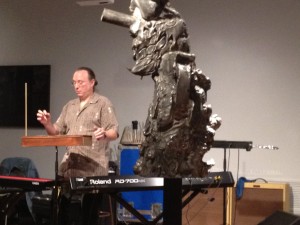Aside from the circulating LED of Aristarkh Chernyshev’s Knode and Erwin Olaf’s video Dusk to Dawn, the pieces that make up the Dusk to Dusk exhibition are set into a specific place, immobile, allowing the viewer to move around them to observe, to be in control. However, when accompanied by the music of Rob Schwimmer this relationship seemed to take a different form, the audience experienced an entirely different exhibit than if they had come the week before.
Morgan Slade and I discussed our experiences during last week’s performance by professional theramin player Rob Schwimmer. We both had very interesting, and different, views on the performance.

I felt that the music brought the art to life with its eerie unnatural sounds, sounds expected to remain in horror films. The pieces of art in Dusk to Dusk look like stills from a horror movie by themselves, and when Schwimmer’s music was paired with the art, they seemed to come alive. Schwimmer’s theramin ballad gave life to Jonathan Meese’s bronze sculpture CHIPS-TEUFEL, and I could picture it slowly, quietly, dancing through the gallery and terrorizing the other art. Since the sculpture was the closest piece of art to both the audience and Schwimmer, it came to life first. Then slowly other pieces began the emerge. The little girl in Desiree Dolron’s dye destruction print Cerca Villegas started slowly pirouetting down the street in Cuba, twirling and twirling, her face never seen as she slowly disappears into the haze. The image is meant to be beautiful, yet quietly disconcerting: the child dancing down the street brings warm feelings to your heart, but then you realize that she is disappearing into the haze of the street and become concerned for her well-being. You could see the face in Hideaki Kawashima’s painting I30 starting to morph into other shapes, like an amoeba it had no solid form. It was moving with the music.
The music played through Rob Schwimmer’s unusual collection of interesting instruments took the audience’s mind into a creative realm where you forget about the world and look at the art with new eyes, imagining how the art would react to the music. You allow the art to come to life to interact with the music.
After these thoughts came to my mind, I thought of the movie Night at the Museum where the objects in the Smithsonian come to life after dark when the Museum is closed. Those characters were brought to life by a magical tablet, but these pieces in Dusk to Dusk were brought to life by Schwimmer’s unsettling music. The music activated the space.
Have you ever felt this sensation before?
Morgan responded by bringing up a piece she saw at the New Museum in SoHo in New York City.
“The only sensation that I could possibly relate to Schwimmer’s performance alongside the artwork would be my experience with American artist Rober Breer’s Floats. These structures, designed in the 1970’s, were featured in the New Museum’s summer exhibition, Ghosts in the Machine. When I first saw these large, white sculptures in the gallery, I wondered why the Curator had decided to place them in the visitor’s path.
As our tour group was taking note of another work in the space, Stan VanDerBeek’s movie Dome, I felt one of the floats lightly graze the side of my leg. I didn’t think I had moved, so I decided to ignore its presence and moved onto another work. Like an old dog following its owner, the structure returned to touch my leg a second time. This experience, in which the artwork begins to take on a living quality, was exactly how I felt as Schwimmer played in the gallery.”
Have you ever been in a gallery when it “came to life”?
Katrina Hefele ’13
Morgan Slade ’13
